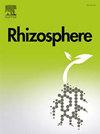Differential stimulation of phosphorus-mobilizing bacteria by common bean genotypes in Amazonian Dark Earth and Agricultural Soils with varying fertility levels
IF 3.4
3区 生物学
Q1 PLANT SCIENCES
引用次数: 0
Abstract
Phosphorus (P) is an essential element for plant metabolism and often limits agricultural production due to its strong immobilization in soils. Microbial activity plays a crucial role in nutrient cycling, particularly in mobilizing P for plant uptake. This study evaluated how plants with different P use efficiencies influence the structure, diversity, and composition of the microbial community, with a focus on P-mobilizing bacteria, in soils with varying fertility levels. We hypothesized that plants with contrasting P use efficiencies differentially recruit rhizosphere microbiota associated with the P cycle. To test this hypothesis, a greenhouse experiment was conducted using two common bean (Phaseolus vulgaris L.) genotypes, BAT 477 (G1) and DOR 364 (G2), known for their contrasting P assimilation efficiencies. The common beans were grown in Amazonian Dark Earth (ADE) and agricultural soil (AS) until the pre-flowering phenological stage (R5). Rhizosphere and bulk soil (BS) samples were collected for microbiological, enzymatic, and P fractionation analyses. Amplicon sequencing revealed that the composition and relative abundance of the prokaryotic community were significantly influenced by the common bean genotypes across the different soil types. Acid phosphatase activity was approximately 22% higher in the rhizosphere than in BS for both genotypes, irrespective of soil type. Alkaline phosphatase activity, however, exhibited distinct patterns: in ADE, G1 showed 48% higher activity than BS, while in AS, G2 displayed the highest activity, with a 33.6% increase compared to BS. Redundancy analysis (RDA) in ADE revealed three distinct clusters (G1 ≠ G2 ≠ BS), indicating genotype-specific microbial recruitment patterns with significant positive correlations to the moderately labile P fraction. In AS, only two clusters were observed (G1+G2 and BS), with positive correlations to the moderately labile P fraction but no distinction between genotypes. These findings demonstrate that plants with differing P assimilation efficiencies distinctly modulate the rhizosphere microbiome, influencing P mobilization in a soil fertility-dependent manner. This study highlights the potential of leveraging plant-microbe interactions to enhance P cycling and utilization in agricultural systems, paving the way for more sustainable and efficient crop production practices.
求助全文
约1分钟内获得全文
求助全文
来源期刊

Rhizosphere
Agricultural and Biological Sciences-Agronomy and Crop Science
CiteScore
5.70
自引率
8.10%
发文量
155
审稿时长
29 days
期刊介绍:
Rhizosphere aims to advance the frontier of our understanding of plant-soil interactions. Rhizosphere is a multidisciplinary journal that publishes research on the interactions between plant roots, soil organisms, nutrients, and water. Except carbon fixation by photosynthesis, plants obtain all other elements primarily from soil through roots.
We are beginning to understand how communications at the rhizosphere, with soil organisms and other plant species, affect root exudates and nutrient uptake. This rapidly evolving subject utilizes molecular biology and genomic tools, food web or community structure manipulations, high performance liquid chromatography, isotopic analysis, diverse spectroscopic analytics, tomography and other microscopy, complex statistical and modeling tools.
 求助内容:
求助内容: 应助结果提醒方式:
应助结果提醒方式:


